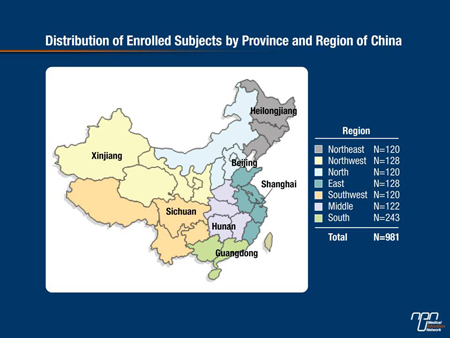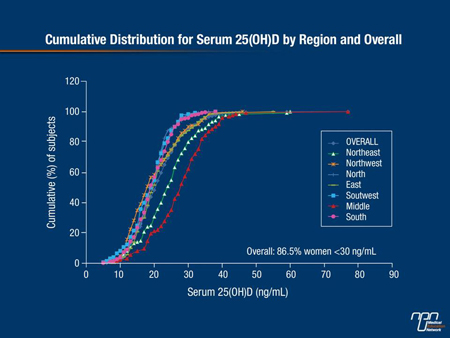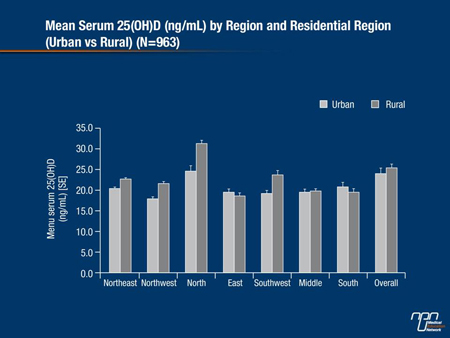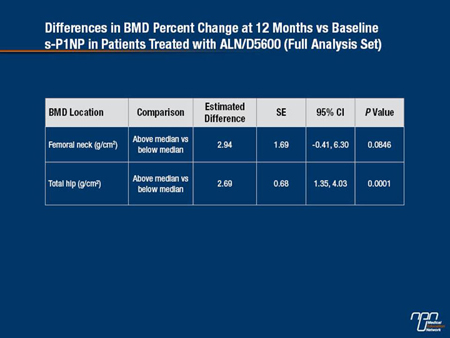Reports
Early Diagnosis and Treatment of Risk Factors for Osteoporosis Offer Major Opportunity Reduce Fracture Risk in China
This report is based on medical evidence presented at sanctioned medical congress, from peer reviewed literature or opinion provided by a qualified healthcare practitioner. The consumption of the information contained within this report is intended for qualified Canadian healthcare practitioners only.
MEDICAL FRONTIERS - 36th Annual Meeting of the American Society for Bone and Mineral Research (ASBMR)
Houston, Texas / September 12-15, 2014
Houston - Several factors explain the rapidly rising rate of fractures due to osteoporosis in China. One is the increasing proportion of the population over the age of 60. Another is the high rate of vitamin D deficiency, a nutrient critical to bone metabolism. Data collected by the International Osteoporosis Foundation (IOF) indicate average vitamin D levels in China are often below recommended levels even among children. Among postmenopausal women, the proportion with suboptimal vitamin D exceeds 85%, according to new cross-sectional data presented at the ASBMR. Although osteoporosis is a common complication of aging, other data presented at the ASBMR re-emphasized that both bone mineral density loss and vitamin D deficiency are reversible. These data outline an important opportunity to reduce the high morbidity associated with osteoporosis in China, encouraging initiatives to avert a major public health crisis through early diagnosis and appropriate therapy.
Osteoporosis is a common disease of aging with an accelerated rise among women following menopause. In many countries with lengthening lifespans and aging populations, osteoporosis has been identified as a major and growing cause of morbidity and mortality. In China, where the population of individuals over the age of 60 reached 200 million in 2013, inadequate levels of vitamin D are exacerbating the problem. New data presented on vitamin D deficiency among postmenopausal women in China presented at the American Society for Bone and Mineral Research (ASBMR) support previously collected data from the International Osteoporosis Foundation (IOF).
Vitamin D Deficiency Common in China
“Vitamin D deficiency and insufficiency, by any definition, are common among postmenopausal women in China, even during the summer, and especially among those living in urban areas,” reported Dr. Zhongjian Xie, Institute of Endocrinology and Metabolism, Second Xiangya Hospital, Central South University, Changsha, China. According to Dr. Xie, who presented results of a cross-sectional study involving seven geographically distinct areas in China, 86.5% of postmenopausal women have vitamin D levels below 30 ng/mL, which defines normal, and 44.1% have levels below 20 ng/mL, which defines clinically significant deficiency.
These data add greater specificity and detail about the problem initially outlined by the IOF in the 2013 Asia-Pacific Regional Audit (available at www.iofbonehealth.org). In that analysis, China was again identified as a nation whose increased risk of osteoporosis could be predicted on the basis of low average vitamin D levels. In that report, based on a systematic review of published studies, the potential explanations offered for low vitamin D levels in China included low dietary intake, less food vitamin D fortification relative to Western countries, and declining rates of sun exposure as more people move to cities.
“With a growing life expectancy, China is expected to soon have the highest number of fractures due to osteoporosis in the world,” cautioned Judith Stenmark, Chief Executive Officer, IOF, who was asked for a comment. She suggested that therapy to increase vitamin D levels, given the prevalence of deficiency, “could make a substantial difference to falls and fracture prevention.”
Separate Study on Osteoporosis Treatment
Both the multicenter study led by Dr. Xie and the data from the IOF emphasize the need to consider osteoporosis risk in China and to implement prophylaxis and treatment strategies. For treatment, the value of combining vitamin D with an active therapy to regain bone density was highlighted in a separate study conducted in China and led by Dr. Zhen Lin Zhang, Shanghai Sixth People’s Hospital, Shanghai Jiaotong University, Shanghai, China. Together, the data outline a viable strategy toward risk reduction.
In the cross-sectional analysis, postmenopausal women at least 55 years of age were recruited from seven distinct communities across China (see Figure 1). Fasting blood samples were drawn to evaluate vitamin D levels at a central laboratory. Bone mineral density was also evaluated using dual energy X-ray absorptiometry (DEXA). Demographic data were collected, and all participants were interviewed about general health, sun exposure, and dietary consumption of foods containing vitamin D.
Figure 1.

Vitamin D levels (expressed as serum 25-hydroxy-vitamin D [25(OH)D] among postmenopausal women were below normal in all regions for both urban and rural groups with the sole exception of rural women in the North. In the seven regions (Northeast, Northwest, North, East, Middle, Southwest, and South), the mean vitamin D levels were tightly correlated (see Figure 2), and the average levels were generally near or below the cut-off for deficiency, meaning that nearly half of the women were deficient. In several regions, the proportion of women with extreme deficiency (<15 ng/mL) was substantial, reaching 21.7% in the Southwest and 28.3% in the Northwest.
Figure 2.

Deficiency Greatest in Urban Women
In urban populations, the likelihood of vitamin D deficiency was consistently greater. Whereas the majority of both groups had below recommended levels (<30 ng/mL), the proportion of the urban women who were deficient (<20 ng/mL) exceeded 50% and the proportion with extreme deficiency (<15 ng/mL) exceeded 20% (see Figure 3).
“Physicians and especially surgeons in China are not aware of the importance of vitamin D deficiency. Most focus on calcium levels without understanding the importance of vitamin D for calcium metabolism,” reported Dr. Wang Li, Chief Physician of Orthopedics, Institute of Tianjin Hospital, Tianjin, China. Asked for her opinion about the significance of these findings,
Dr. Li said reported that they may be an underestimate. In her experience, 85% to 90% of the women she tests for vitamin D are deficient, emphasizing that “more education is needed” to address a preventable cause of osteoporosis.
The health threat posed by osteoporosis is widespread in Asia, where the rates of hip fractures have more than doubled in most countries over the last 30 years. China is not an exception. The IOF report cited one study of hip fractures that calculated a nearly 60% increase in women and a nearly 50% increase in men since 2002.
Figure 3.

Vitamin D Role in Treatment
Due to its role in improving bone metabolism, reversing vitamin D deficiency is important for both prevention and treatment of osteoporosis. However, in patients who already have osteoporosis, additional therapy is required. Of therapies for osteoporosis, the bisphosphonate alendronate is among the most commonly used worldwide. New data presented at the ASBMR specific to China have reinforced the efficacy of alendronate plus vitamin D relative to vitamin D alone.
The data presented at the ASBMR involved a new analysis of a trial in which 219 women were randomized to receive a combination of alendronate plus vitamin D or to receive vitamin D alone. In the combination arm, 70 mg alendronate and 5600 IU of vitamin D were taken in a single pill once weekly. This was compared to 0.25 µg of calcitriol taken daily. Calcitriol was selected for comparison because it is one of the most commonly prescribed forms of vitamin D supplementation in China. The original study was designed as a 6-month comparison, but data presented at ASBMR included an analysis out to 12 months with attention given to which patients benefited most from the combination.
The initial study at 6 months “demonstrated superior efficacy for the combination versus calcitriol on increases in bone mineral density, increases in vitamin D, and decreases in markers of bone turnover among Chinese women with osteoporosis,” reported Dr. Zhang. In the most recent analysis, these relative advantages were found to be greater both in those with greater risk of bone mineral loss from increased bone turnover and in those with vitamin D insufficiency at baseline.
Restoring Healthy Bone Metabolism
These results are not surprising because vitamin D therapy, although helpful to bone metabolism, would be expected to provide only modest improvement in bone density among patients who already have clinically significant osteoporosis. Alendronate is chemically related to the endogenous pyrophosphate, which inhibits osteoclasts and their activity on bone resorption. This effect is reflected in a downregulation of bone turnover markers, such as s-P1NP.
In the data from the China trial, the new findings demonstrate that the greatest effect of the combination of alendronate plus vitamin D was achieved in those with low vitamin D at baseline. When the study population, which had a mean vitamin D level at baseline of 19 ng/mL, was divided into baseline vitamin D tertiles, those in the second and third tertile had significantly greater vitamin D increases (P<0.05) at 12 months than those in the first tertile (see Figure 3). Similarly, when improvement in bone density at 12 months was evaluated in those below or above the median for the bone turnover marker s-P1NP at baseline, there were significant differences for the lumbar spine (P=0.0216) and total hip (P=0.0001) with a trend in the femoral neck (P=0.0846) favouring the combination (see Table 1).
Table 1.

After 12 months on the combination “increases in bone mineral density were greater in those women with higher baseline bone turnover markers and increases in vitamin D were greater in women with greater vitamin D insufficiency at baseline,” Dr. Zhang confirmed. These data reinforce the importance of combining vitamin D with a therapy for osteoporosis.
Asked for her opinion on the study data, Dr. Li, who was a participating investigator, said the results “provide important information for physicians” by emphasizing the importance of combining vitamin D with an active agent like alendronate. In her experience, these offer a synergistic effect for increasing bone density, but she also reports that she individualizes therapy. In those with severe vitamin D deficiency, she considers augmenting vitamin D beyond the 5600 IU used in the study protocol.
Other ASBMR data, including a study conducted in 514 Korean women undergoing a health evaluation, reinforced the role of vitamin D. When women with baseline vitamin D deficiency were followed for one year, femoral neck bone density increased in those with increased vitamin D levels but not in those whose levels did not increase. According to the lead author, Dr. Duckjoo Lee, Ajou University School of Medicine, Suwon, Korea, the data emphasize the importance of correcting vitamin D to increase bone quality in the femoral neck, which is a common site of hip fracture.
The biggest hurdle to reducing the morbidity associated with osteoporosis may be the lack of bone density screening in at-risk populations. In many parts of the world, this type of screening is now routinely performed in all postmenopausal women. In China, the IOF Audit warned of a significant deficiency in DEXA equipment, which provides the most accurate method of diagnosis, but increasing awareness among physicians to recommend screening, prophylaxis, and treatment, may be a more important task to reduce the impact of a growing public health problem.
Conclusion
The morbidity associated with osteoporosis, an under-recognized and under-treated disease, is expected to produce a growing public health crisis in China. Among the many factors contributing to the growing rates of fracture due to osteoporosis in China is the prevalent vitamin D deficiency that is observed at all ages. Early diagnosis and treatment of osteoporosis will become increasingly essential as the proportion of postmenopausal women and aging men grow within the Chinese population. In those with osteoporosis, new data from China support previous evidence that vitamin D with alendronate increases bone mineral density, particularly in those with low baseline vitamin D levels and active bone mineral turnover.